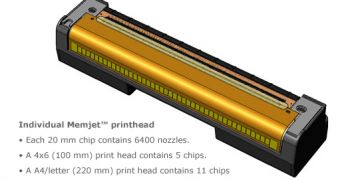A new breakthrough in printing technology has been developed by Silverbrook Research, an Australian based company involved in a variety of areas including printerhead design, image processing, networking architecture, optics and more.
This new technology they have developed is called Memjet and has the advantage of offering "radically (low) price/performance levels". The basic structure of the Memjet technology is comprised of four elements: page-width printheads, driver chips, ink and software. In a nutshell, it's the whole package.
Each printhead is made out of individual microchip segments, joined into a page-width printing system. The chip that measures 20mm across contains 6400 nozzles and an entire printing system can drop 900 million drops of ink through 70.400 nozzles, the size for an A4 printer, and is able of printing 60 full color A4 pages per minute.
They also have this technology integrated into four segments of printing based upon the different customers' needs. The document printer is the one we've discussed about, able to print full color A4 pages at the rate of 60 per minute and, not to forget, at a 1600-dpi resolution. Then there is the photo printer, able to print 4x6-inch photos once every 2 seconds, at 30 prints per minute. The label printer can do 6 to 12 inches per second and the large format printer, 51-inches in width, can print 6 inches to 1 foot per second.
Robert Palmer, director of printer research for InfoTrends Inc. said: "Memjet's technology delivers on the promise on inkjet for the broader market, with very fast speeds, high-quality color, and significantly lower purchase and operating costs. With its strong patent portfolio, Memjet is in a favorable position to expand the market opportunities in inkjet technology. Clearly, this is a technology to watch".
It all sounds too good to be true, for a not so well known company to come and take the crown off big names in the domain such as HP, Canon and Epson, to name just a few. Even though the company has over a decade of expertise in this line of work, with 452 Memjet-related patents received last year alone, 1.400 in the U.S. and about 2.000 other pending worldwide, newcomers to this field are not that well received, or, if the technology is actually viable, it'll soon be bought by one of those big names I've mentioned earlier.

 14 DAY TRIAL //
14 DAY TRIAL //